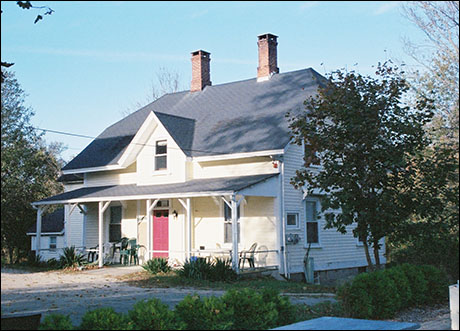The Farmhouse at the very edge of the Eugene O'Neill Theater Center is a hub of activity. A red lamp illuminates the porch, eucalyptus-scented candles ward away bugs and a scarlet barbecue grill chugs out a constant stream of smoke in the corner. With the advent of the National Playwright's Conference (NPC), the clapboard house has become the realm of the Conference's "Dream Design" team.
The design team at the O'Neill is made up of Rachel Hauck and Carolyn Mraz (scenic design), Raquel Davis and Brian Lillenthal (lighting design) and Matt Hubbs and M. Florian Staab (sound design). When they're not grilling some of the best barbecue found on campus, they are conjuring up the ideal production of a playwright's imagination.
The NPC is a retreat for playwrights to work out the wrinkles in their writing. Eight playwrights live for at the O'Neill's idyllic grounds for a month, completely immersed in their work. Each week, there are two public readings of their plays, sometimes under the stars, other times in the cool comfort of a renovated barn.
As the plays are still works in progress, the production aesthetic is intentionally spartan. There is a minimum amount of design, but during the intermission audiences are invited to look at a board covered with images and scenic renderings which aim to capture the essence of the final production.
The board is the result of an intimate meeting between the playwright and the O'Neill's in-house design team. It is a unique aspect of the conference where designers sit on the porch of the farmhouse and discuss the visual elements of the play with the playwright in order to imagine how a final dream production of the play should look. Thus, the term "dream design."
 |
| The Farmhouse |
| |
 |
|
| Preston Whiteway | ||
| Photo by Monica Simoes |
"What we have found is that it is the most vital and important parts of the playwrights' time with us as they develop their play. The world of physics does not apply," he said. "To have this opportunity where we require the directer to sit back and remain silent and turn it all over to the playwright is unique and one of the things that has resulted in how the play ultimately transforms."
August Wilson's Tony and Pulitzer Prize-winning play Fences was workshopped at the O'Neill in 1983. According to Whiteway, it was only through a dream design session that Wilson realized that the play had to be set on a porch.
Twenty years later the dream design process continues to assist playwrights. Samuel D. Hunter, one of the participants of this year's NPC, extolled the assistance provided by the designers.
"It's made me realize that set designers are fantastic dramaturges," said Hunter. "In my writing, I try to pull in designers into my work as soon as possible, because it really is so important to my work." Scenic designer Raquel Davis shared the ethos she has adopted when participating in a dream design workshop. This is an attitude which ties in with the nurturing philosophy of the O'Neill.
"I really listen with my ears," she said. "We are not here to solve the problems of the plays. It is all a suggestion of what the play's world could look like."


Matthew-Murphy.jpg)






